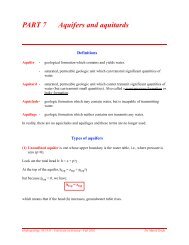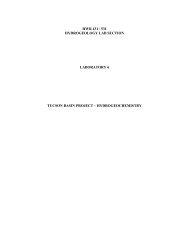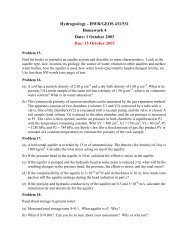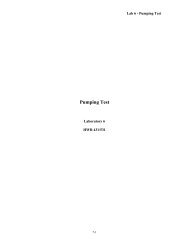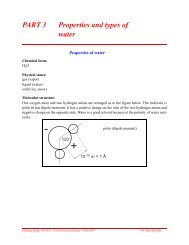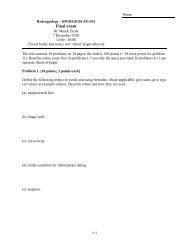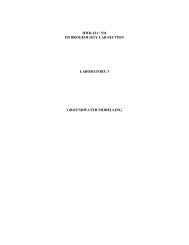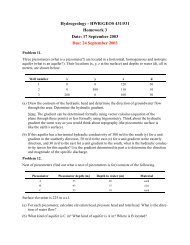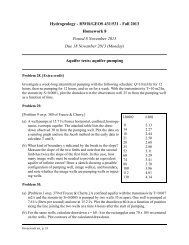PART 12 Aquifer pumping tests - Dr. M. Zreda - University of Arizona
PART 12 Aquifer pumping tests - Dr. M. Zreda - University of Arizona
PART 12 Aquifer pumping tests - Dr. M. Zreda - University of Arizona
Create successful ePaper yourself
Turn your PDF publications into a flip-book with our unique Google optimized e-Paper software.
<strong>Aquifer</strong> <strong>pumping</strong> <strong>tests</strong> 103<br />
Partial penetration<br />
We have 3-D flow due to partial<br />
penetration.<br />
If s = const, partially penetrating<br />
wells give less Q than fully penetrating<br />
wells because more energy<br />
is required to get water up (less<br />
area?).<br />
If Q = const, partially penetrating<br />
well causes more drawdown than<br />
does fully penetrating one.<br />
<strong>Dr</strong>awdown curve far away from s<br />
the <strong>pumping</strong> well looks like fully<br />
penetrating and the slope <strong>of</strong> drawdown curve approaches slope <strong>of</strong> fully penetrating well drawdown.<br />
Penetration is important in calculating S. Do not use the late curve (straight line); use the early<br />
one.<br />
Large diameter well<br />
Has storage, usually built in low-K<br />
aquifers. Specific yield <strong>of</strong> the<br />
well: S y = 1. S is overestimated<br />
(t 1 ). Use t 0 to get S.<br />
s<br />
t 0<br />
wrong<br />
estimation<br />
<strong>of</strong> S<br />
actual<br />
drawdown<br />
fully<br />
penetrating<br />
Hydrogeology, 431/531 - <strong>University</strong> <strong>of</strong> <strong>Arizona</strong> - Fall 2007 <strong>Dr</strong>. Marek <strong>Zreda</strong><br />
t 1<br />
small<br />
diameter<br />
well<br />
t 0<br />
use this to get S<br />
large<br />
diameter<br />
well<br />
log t<br />
log t



